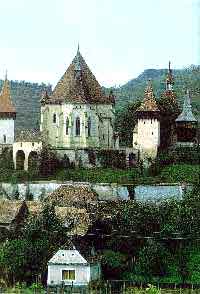
[ Version franšais | Versiune romaneasca ]
|
All along those bleak years, the churches naturally did their best to protect themselves from the neverending wars waged around the principality of Transylvania until the beginning of the 18th century. The grographic density and, above all, the high number of these buildings - of which, over 150 survived to this day - can be considered a phenomenon characteristic of the historical, legal, religious and social environment of those who built them: the Saxons of Transylvania. During one of the many attempts of the Hungarian crown to occupy Transylvania, king Geza the 2nd (1141 - 1161) decided to bring German colonists to the country, especially from the Cologne archdiocese, who later on would be called Saxons. After other immigrants came in, the colonisation of the present Saxon localities would end with a few exceptions, before 1300. From a religious point of view, these communities were linked to the Saxon church. From 1542 to the Reformation, the Saxon church of Transylvania - which had adopted the Augsbourg religion - preserved (and still does) the characteristic of a popular church. |
| Autor: Christoph Machat; Traducere: Virgil Stefan Nitulescu; Webdesign: Cornelia Calin |

